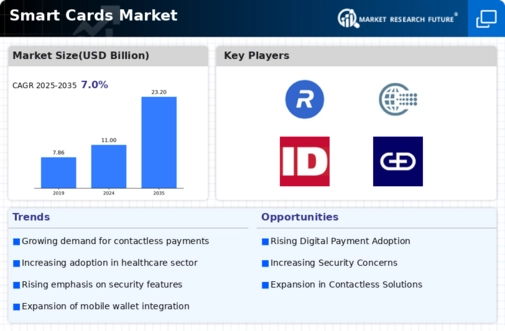Smart Cards Size
Smart Cards Market Growth Projections and Opportunities
The Smart Cards market is influenced by a myriad of factors that collectively shape its dynamics and growth trajectory. One of the primary drivers of this market is the increasing need for secure and efficient payment solutions. As digital transactions become more prevalent, the demand for smart cards, which offer enhanced security features, such as encryption and authentication, continues to rise. This surge is particularly noticeable in the banking and financial sector, where smart cards are widely adopted to safeguard sensitive information and ensure seamless transactions.
Moreover, the growing emphasis on data protection and privacy further propels the Smart Cards market. With increasing instances of cyber threats and identity theft, businesses and individuals alike are seeking robust solutions to safeguard their information. Smart cards, equipped with advanced security features, provide a reliable means to counter these threats, making them an attractive option for various industries, including healthcare, government, and telecommunications.
Technological advancements play a pivotal role in shaping the Smart Cards market landscape. The continuous evolution of smart card technology, including the integration of contactless and near-field communication (NFC) capabilities, enhances user convenience and widens the scope of applications. This evolution not only fosters innovation but also encourages the adoption of smart cards in emerging sectors, such as transportation and access control systems.
The regulatory landscape also significantly impacts the Smart Cards market. Government initiatives and regulations aimed at promoting secure and efficient payment methods contribute to the market's growth. Compliance requirements related to data security and privacy standards further drive the adoption of smart cards across various industries. As businesses strive to adhere to these regulations, the demand for smart cards as a compliant solution continues to grow.
Global economic factors, such as GDP growth and consumer spending patterns, exert a notable influence on the Smart Cards market. As economies expand, there is an increased willingness among businesses and consumers to invest in advanced payment technologies, boosting the market's overall growth. Additionally, the rise of e-commerce and the transition towards a cashless society contribute to the surge in demand for smart cards, as they offer a secure and efficient payment method in the digital landscape.
Competitive dynamics within the Smart Cards market also shape its trajectory. The presence of key players, constant innovation, and strategic partnerships influence market trends. Companies that can offer cost-effective and technologically advanced smart card solutions gain a competitive edge, driving market growth. Additionally, the emergence of new entrants and startups in the smart card industry introduces fresh perspectives and solutions, fostering competition and further expanding the market.
Environmental considerations and sustainability have become increasingly relevant in shaping market trends. As businesses and consumers become more conscious of their environmental footprint, there is a growing preference for eco-friendly smart card materials and manufacturing processes. Companies that prioritize sustainability and incorporate environmentally friendly practices into their smart card production gain a competitive advantage in the market.







Leave a Comment